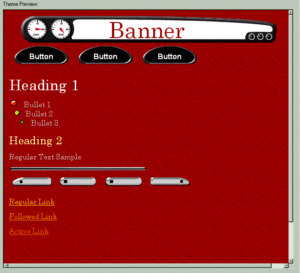Oh, the memories
Today, I ran across this web page touting the features of Microsoft FrontPage 98. Man, this brings back memories. My first job in software outside of computational linguistics was as a QA engineer on the development of AT&T’s Easy World Wide Web business web hosting service. In those early days of the web, AT&T’s assumption was that small business owners would pay $300/month to host their web site but develop the site themselves (In hindsight, that was a terrible assumption. As things settled down, web hosting became a nominal fee and sites were mostly designed by professional web designers). With this business model in mind, AT&T supported Microsoft FrontPage and NetObjects Fusion as WYSIWYG web development tools. AT&T’s service included a separate staging site for development with one-click deployment to production and unlimited telephone support (hence the high price).
FrontPage was widely hated due to its ugly templates, and that hate was justified. But it did so much more than that. It allowed you to create a web site structure automatically drag and drop navigation to every page–navigation that was automatically updated when you added pages or changed the structure. Before this, you had to update every page individually (or use server side includes if you could program in PERL or shell). I learned to create individual page parts, e.g., banner, navigation, footer, etc, created a common template for all the pages in my site using those parts, and I could add pages, completely redo the look and feel (though the basic layout was limited to my template) of colors and images. It made managing web sites easy.
It also allowed the developer to include common interactive features such as hit counters, standard forms such as feedback forms and custom forms that either saved the posted results to a text file on the web server or emailed them to you. To be fair, these ‘bots,’ as they called them, required a web server running the FrontPage server extensions, but Microsoft supported extensions for its own IIS web server as well as other common web server software that ran at the time on UNIX and BSD systems (to be fair, the tool supported these other server architectures when Microsoft acquired it; if Microsoft had developed it themselves, I’m sure it would have only run with IIS).
You could edit your web pages in the WYSIWYG editor or edit the HTML directly, and what I found amazing at the time, you could switch between modes. If you added non-compliant HTML by hand, the editor didn’t complain about it and tried its best to display it as the browser would. Because HTML development was originally performed by hand without tools to validate the HTML, browsers and other tools had to be very tolerant of non-compliant HTML code.
I tested FrontPage support at AT&T and used it for several years for my own personal web development. This web site that I found brings back so many memories.


